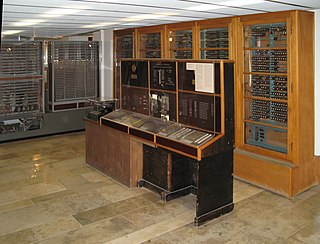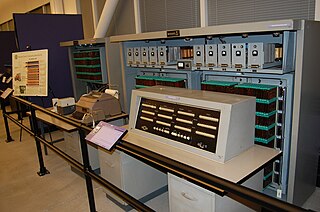 W
WKonrad Zuse was a German civil engineer, pioneering computer scientist, inventor and businessman. His greatest achievement was the world's first programmable computer; the functional program-controlled Turing-complete Z3 became operational in May 1941. Thanks to this machine and its predecessors, Zuse has often been regarded as the inventor of the modern computer.
 W
WCalculating Space is Konrad Zuse's 1969 book on automata theory. He proposed that all processes in the universe are computational. This view is known today as the simulation hypothesis, digital philosophy, digital physics or pancomputationalism. Zuse proposed that the universe is being computed by some sort of cellular automaton or other discrete computing machinery, challenging the long-held view that some physical laws are continuous by nature. He focused on cellular automata as a possible substrate of the computation, and pointed out that the classical notions of entropy and its growth do not make sense in deterministically computed universes. Zuse's thesis was later expanded by German computer scientist Jürgen Schmidhuber in his book Algorithimic Theories of Everything.
 W
WThe Z1 was a motor-driven mechanical computer designed by Konrad Zuse from 1936 to 1937, which he built in his parents' home from 1936 to 1938. It was a binary electrically driven mechanical calculator with limited programmability, reading instructions from punched celluloid film.
 W
WThe Z3 was a German electromechanical computer designed by Konrad Zuse in 1935, and completed in 1941. It was the world's first working programmable, fully automatic digital computer. The Z3 was built with 2,600 relays, implementing a 22-bit word length that operated at a clock frequency of about 5–10 Hz. Program code was stored on punched film. Initial values were entered manually.
 W
WThe Z4 was arguably the world's first commercial digital computer. It was designed by German engineer and early computer scientist Konrad Zuse and built from 1942 to 1945 by the company he founded, Zuse Apparatebau. The Z4 was Zuse's final target for the Z3 design. Like the earlier Z2, it comprised a combination of mechanical memory and electromechanical logic, so was not a true electronic computer.
 W
WThe Z11 was a computer, the first serially produced machine of the Zuse KG.
 W
WThe Z22 was the seventh computer model Konrad Zuse developed. One of the early commercial computers, the Z22's design was finished about 1955. The major version jump from Z11 to Z22 was due to the use of vacuum tubes, as opposed to the electromechanical systems used in earlier models. The first machines built were shipped to Berlin and Aachen.
 W
WThe Zuse Z23 was a transistorized computer first delivered in 1961, designed by the Zuse KG company. A total of 98 units were sold to commercial and academic customers up until 1967. It had a 40-bit word length and used an 8192 word drum memory as main storage, with 256 words of rapid-access ferrite memory. It operated on fixed and floating-point binary numbers. Fixed-point addition took 0.3 milliseconds, a fixed point multiplication took 10.3 milliseconds. It was similar in internal design to the earlier vacuum tube Z22. Related variants were the Z25 and Z26 models.